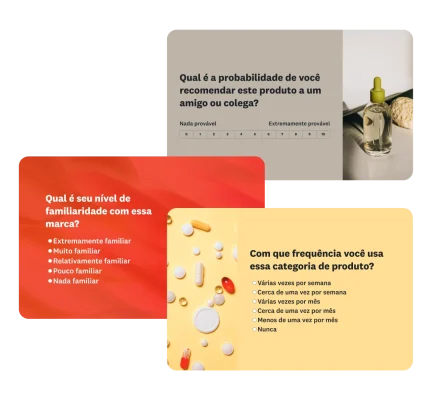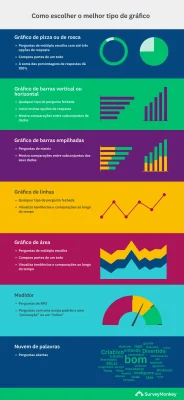Pesquisa de mercado: o que é, como fazer e exemplos
Saiba como fazer pesquisas de mercado e entrar em novos mercados, satisfazer clientes e lançar novos produtos.

A pesquisa de mercado fornece às empresas uma visão abrangente e com base em dados sobre clientes, tendências e concorrentes. Ao realizar pesquisas de mercado, as empresas podem obter os dados exatos de que precisam para entrar em novos mercados, satisfazer seus clientes e lançar novos produtos com confiança.
Isso é fundamental, pois mais de 70% de todos os produtos lançados para o dia a dia fracassam após o lançamento. Fazer uma pesquisa de mercado com antecedência reduz consideravelmente esse risco e aumenta seu sucesso, alinhando sua estratégia de negócios às necessidades de clientes.
O sucesso nos negócios começa com uma boa pesquisa de mercado.
O que é uma pesquisa de mercado?
A pesquisa de mercado é o processo de coleta de informações sobre comportamentos e preferências de consumidores, tendências de categorias e inteligência competitiva.
As organizações normalmente conduzem pesquisas de mercado para respaldar seu desenvolvimento de produtos e suas estratégias de entrada no mercado e, por fim, impulsionar suas vendas. Essas constatações revelam um caminho claro para atender à demanda de clientes, lucrar mais e lançar produtos.
Leitura relacionada: O que é pesquisa de mercado e como usá-la para ter sucesso?
Tipos de pesquisa de mercado
É um erro pensar que a pesquisa de mercado é sempre a mesma coisa. Na verdade, a pesquisa de mercado é um termo abrangente que inclui vários tipos de pesquisa, por isso é possível obter uma infinidade de dados e constatações para tomar decisões de negócios com confiança.
- A pesquisa primária ocorre quando você coleta dados originais que respondam a uma dúvida específica.
- A pesquisa secundária ocorre quando você analisa dados existentes publicados por outras instituições que podem ser usados para tirar suas dúvidas.
Entender esses dois tipos de pesquisa de mercado, seus métodos de pesquisa e seus casos de uso pode ajudar a criar um projeto de pesquisa que tire suas dúvidas de forma eficaz.
Pesquisa primária
A pesquisa primária é útil quando uma empresa dificilmente encontraria dados públicos especificamente sobre as dúvidas em questão. Esse é especialmente o caso quando uma empresa está avaliando seus próprios produtos e serviços.
Veja a seguir alguns métodos usados pelos pesquisadores de mercado:
- Os questionários são um método predominantemente quantitativo de coleta de informações de uma grande carteira de respondentes por meio de perguntas padronizadas. Eles ajudam as empresas a entender as preferências de clientes, os comportamentos de compra, os níveis de satisfação e a demanda do mercado. Os questionários também podem coletar alguns dados qualitativos na forma de perguntas abertas.
- Entrevistas são conversas individuais que fornecem insights sobre as motivações, as percepções e os processos de tomada de decisão de cada cliente. As entrevistas aprofundadas permitem uma análise mais profunda de temas complexos que podem não ser mencionados em métodos de grupo.
- Os grupos focais são conversas guiadas com um pequeno grupo de clientes que revelam opiniões e reações coletivas a ideias de negócio, produtos, serviços ou estratégias de marketing.
- As formas de pesquisa de mercado online, como a de análise de dados da web, o monitoramento de redes sociais e os questionários de pesquisa de mercado, coletam dados em tempo real sobre comportamentos de clientes, tendências de mercado e posicionamento competitivo.
- O teste de produto permite que possíveis clientes usem um produto em condições controladas ou reais. O testes de produto ajuda a identificar problemas de usabilidade, prever a satisfação de clientes e ajustar as ofertas antes do lançamento em larga escala.
Pesquisa secundária
As empresas acham as pesquisas de mercado secundárias úteis quando querem obter dados sobre um tema que já foi investigado. Dúvidas mais gerais muitas vezes já têm respostas publicadas disponíveis para consulta.
Entre os métodos secundários de pesquisa de mercado, temos:
- Os relatórios de setor são elaborados por empresas de pesquisa, associações comerciais ou consultorias. Os relatórios fornecem insights detalhados sobre tamanho de mercado, tendências de crescimento, principais concorrentes e perspectivas futuras. Esses relatórios permitem que as empresas comparem seu desempenho com referências, identifiquem oportunidades emergentes e tomem decisões estratégicas embasadas.
- A análise de concorrência é uma avaliação sistematizada da concorrência direta e indireta para entender seus pontos fortes e fracos. Essa análise permite que as empresas descubram lacunas no mercado, se diferenciem com mais eficiência e prevejam escolhas da concorrência.
- As publicações do governo incluem indicadores econômicos, estatísticas demográficas, dados comerciais e informações regulatórias. Essas publicações oferecem recursos confiáveis, e muitas vezes gratuitos, para validar hipóteses de mercado e garantir a conformidade com os padrões legais e do setor.
Como conduzir uma pesquisa de mercado: um guia passo a passo
A pesquisa de mercado é um processo detalhado que requer visão e certo planejamento avançado. Planejar sua pesquisa ajudará a lançá-la, a coletar insights e a converter dados em medidas práticas para melhorar sua organização.
Estas são as etapas para seguir ao conduzir uma pesquisa de mercado.
Etapa 1: defina os objetivos da pesquisa
A dúvida que uma pesquisa quer tirar e seus objetivos finais com isso definem tudo, desde a coleta de dados até o método de análise.
A dúvida de negócio é um resumo do problema que você está tentando resolver e o contexto de como isso se encaixa na sua empresa. São metas ou desafios de alto nível vinculados diretamente aos objetivos da empresa. Por exemplo, “Por que as vendas estão diminuindo?”.
O objetivo de uma pesquisa descreve informações ou métricas específicas que você pretende descobrir. Por exemplo, um objetivo pode ser medir o reconhecimento de marca para entender como ele está afetando as vendas.
Definir objetivos específicos e relevantes para sua pesquisa é importante para escrever perguntas mais tarde. Veja a seguir alguns exemplos de dúvidas de negócio e objetivos de pesquisa.
| Dúvida de negócio | Objetivo de pesquisa |
| Comportamento de consumidores: estamos pensando em investir em algumas empresas de streaming de vídeo e precisamos entender o panorama atual e as percepções sobre o setor para investirmos bem. | Saber quais são as marcas de tecnologia e aplicativos mais populares entre a geração Y. Capturar pontos de prova sobre a quantidade e a satisfação com os aplicativos que esse público usa. Entender o uso e as opiniões da geração Y sobre serviços de streaming. |
| Teste de anúncio: estamos prestes a lançar nossa nova ração no mercado, e nossos designers desenvolveram vários conceitos de anúncios impressos. Como escolheremos um design? | Comparar a atratividade e a preferência por cada design de anúncio entre os consumidores. Identificar por qual design os consumidores estariam dispostos a pagar mais. Avaliar as diferenças em cada perfil demográfico de consumidores, se houver. |
| Monitoramento da marca: somos uma marca estabelecida de água gaseificada, mas muitas novas marcas surgiram no ano passado. O que isso significa para nós? | Medir a consciência de marca de todas as principais marcas do setor. Avaliar a percepção e as associações das pessoas a cada marca. Entender a adesão à nossa marca e aos novos concorrentes. |
Etapa 2: identifique seu público-alvo
Identificar seu público-alvo antes de conduzir uma pesquisa de mercado permite coletar dados relevantes e precisos, adaptar sua abordagem, otimizar seus recursos e desenvolver estratégias eficazes.
Para alcançar isso, você precisa entender seu público-alvo, sua composição demográfica, situação de emprego, composição firmográfica, se for o caso, hábitos de compra e atributos comportamentais.
Além disso, ao identificar seu público-alvo, você também pode identificar o escopo. Às vezes, você quer alcançar um público amplo para conduzir uma pesquisa exploratória de possíveis mercados. Outras vezes, pode querer alcançar um grupo mais específico para entender suas preferências de consumo.
Esses objetivos também afetam como você aborda seu público-alvo. Duas ótimas opções são:
- Aproveitar contatos anteriores, como clientes visitantes do site, assinantes de seu boletim informativo e seguidores das redes sociais. Algumas maneiras comuns de abordar contatos existentes incluem por email, postagem em redes sociais, incorporando uma pesquisa de marketing no seu site ou adicionando um link ou código QR a um recibo.
- Escolher entre opções predefinidas de segmentação usando ferramentas como o SurveyMonkey Audience, que dá acesso a um público de mais de 335 milhões de pessoas, oferecendo opções de segmentação avançadas.
Etapa 3: escolha seu método de pesquisa
Selecionar seu método de pesquisa é fundamental para desenvolver e lançar um projeto de pesquisa de mercado. O tipo de pesquisa que você escolher; qualitativa, quantitativa ou mista; influencia diretamente a profundidade, confiabilidade e aplicabilidade dos resultados colhidos, o que torna essa decisão algo crucial para o sucesso do projeto.
O método certo depende dos objetivos da sua pesquisa.
- Métodos qualitativos, como entrevistas ou grupos focais, podem ser econômicos se estiver tentando explorar as motivações e percepções de seus clientes atuais.
- Ferramentas quantitativas, como pesquisas e dados analíticos online, fornecem dados estruturados e estatisticamente significantes ao tentar medir comportamentos, preferências e tendências em larga escala.
- Também é possível usar a análise de dados secundários, dependendo dos seus recursos e insights desejados.
Embora um ou dois métodos primários normalmente funcionem melhor para seu caso, é importante lembrar que a pesquisa nem sempre pode ter uma abordagem padronizada.
Combinar vários métodos, como enviar uma pesquisa na sequência de entrevistas aprofundadas, pode proporcionar uma visão mais completa do seu mercado. Cada método tem suas vantagens, e usá-los juntos permite validar suas observações, descobrindo insights com valor prático, e criar uma estratégia forte e baseada em evidências.
Etapa 4: analise os dados
A pesquisa de mercado não termina na coleta de dados. A análise de dados envolve examinar e interpretar dados de forma sistemática para descobrir padrões, tendências e insights que embasam sua tomada de decisões.
Comece com dados limpos e completos
Antes de analisar os resultados, verifique se seu conjunto de dados está limpo. Remova respostas de baixa qualidade e aguarde até que todas as respostas cheguem para evitar resultados distorcidos (por exemplo, devido a diferenças de fuso horário ou perfil demográfico). Certifique-se de que sua amostra represente com precisão sua população-alvo. Se não representar, aplique pesos aos resultados para corrigir desequilíbrios.
Verifique a significância estatística
Ao comparar os resultados entre grupos demográficos ou períodos diferentes, certifique-se de que as diferenças sejam estatisticamente significantes antes de tirar conclusões.
A significância estatística indica se as respostas de um grupo diferem significativamente das de outro grupo por meio de testes estatísticos. Quando a diferença entre os grupos de amostra é estatisticamente significante, você pode ter certeza de que seus resultados representam uma característica de uma população real, e não uma variação aleatória da sua amostra.
Uma regra prática é verificar se os intervalos de confiança de duas estimativas se sobrepõem. Se eles não se sobreporem, é provável que a alteração seja estatisticamente significante.
O intervalo de confiança é calculado adicionando ou subtraindo a margem de erro de uma estimativa. É possível verificar sua margem de erro usando uma calculadora de margem de erro ou a tabela abaixo como um guia. Como regra geral, a margem de erro diminui à medida que a amostra aumenta.
| Tamanho da amostra | Margem de erro (com nível de confiança de 95%) |
| 50 | +/- 14% |
| 100 | +/- 10% |
| 150 | +/- 8% |
| 250 | +/- 6% |
| 400 | +/- 5% |
| 600 | +/- 4% |
| 1.100 | +/- 3% |
| 2.500 colaboradores | +/- 2% |
Por exemplo, digamos que você aplique uma pesquisa a 400 pessoas e estime que a consciência de marca entre os homens é de 45% e entre as mulheres é de 60%. Considerando uma margem de erro de ± 5 pontos percentuais, o intervalo de confiança para homens é de 40% a 50%, e o intervalo de confiança para mulheres é de 55% a 65%. Como esses intervalos de confiança não se sobrepõem, a diferença provavelmente é estatisticamente significante.
Acompanhe as tendências ao longo do tempo
Conduzir pesquisas ao longo do tempo, mensalmente, trimestralmente ou de forma contínua, ajuda a comparar e monitorar as mudanças de comportamento dos clientes, a percepção da marca e a dinâmica do mercado. Mas lembre-se de manter os critérios de segmentação e a metodologia iguais a cada monitoramento. Apenas o tempo deve mudar.
A análise de tendências ao longo do tempo, combinada à precisão estatística, fornece insights confiáveis que levam a decisões inteligentes e baseadas em dados.
Etapa 5: apresente suas conclusões
Ao receber o resultado da sua pesquisa de mercado, você provavelmente olhará as respostas agregadas de toda a amostra de respondentes. Verificar a forma como cada segmento da sua população responde à sua pesquisa de mercado é uma maneira de descobrir insights que podem ser fundamentais para sua análise.
Estes são alguns segmentos da sua amostra que você pode verificar:
- Segmentos demográficos: gêneros, faixas etárias, etc.
- Segmentos geográficos: países, regiões, estados, etc.
- Segmentos comportamentais: compradores frequentes da categoria de produto, compradores econômicos, etc.
Além disso, existem duas maneiras principais de segmentar seus resultados para descobrir insights mais profundos:
- Filtrar os resultados para ver como certos segmentos responderam.
- Fazer comparações entre diferentes segmentos ou com os dados gerais para descobrir diferenças importantes.
Por exemplo, na pesquisa de consciência de marca de uma água gaseificada, as mulheres demonstraram bem mais consciência de marca do que os homens. Essa diferença foi ainda mais expressiva com marcas como San Pellegrino e Perrier, enquanto marcas como Minalba e Prata mostraram diferenças menores.
Ao segmentar os dados, sempre considere o tamanho das carteiras segmentadas. Por exemplo se sua amostra total tiver 300 pessoas, segmentá-la por estado pode render apenas algumas respostas por estado, sendo insuficiente para tirar conclusões confiáveis.
Etapa 6: apresente suas descobertas
Encontrar uma narrativa clara e lógica nos seus dados é a maneira mais eficaz de deixar uma impressão duradoura e capturar a atenção da liderança.
Prepare a narrativa para que essas pessoas entendam o contexto antes de ver suas descobertas e recomendações Uma estrutura de comunicação, como a SCPA, pode ajudar com sua apresentação.
SCPA significa situação, complicação, pergunta e resposta.
- Situação: o contexto de negócio atual e fatos conhecidos.
- Complicação: o principal problema que motivou a pesquisa.
- Pergunta: as perguntas feitas na pesquisa e sua abordagem para obter as respostas.
- Resposta: os insights importantes que tiram a dúvida de negócio e orientam ações.

Além da narrativa, os dados numéricos sustentam suas conclusões e recomendações.
As estatísticas mais poderosas são as que sustentam sua afirmação com números altos. Isso porque, qualquer porcentagem acima de 50% já representa uma maioria.
Se os dados que sustentam sua narrativa não forem uma estatística envolvente, tente reformulá-los.
Em vez de “10% das pessoas se sentiriam seguras em um carro autônomo”, experimente “90% das pessoas entrevistadas não se sentiriam seguras”. Tenha em mente que, em casos em que você fará uma análise estruturada (por exemplo, ao criar uma tabela de desempenho), reformular as afirmações dessa forma não funcionará.
Para sustentar ainda mais suas afirmações, também é possível criar uma visualização dos dados.
Uma pesquisa da SurveyMonkey sugere que 42% das pessoas acharam os dados na forma de gráficos e infográficos mais agradáveis do que dados em uma frase ou apresentados em uma tabela.
Estes são alguns tipos comuns de gráficos e quando usá-los:

Etapa 7: reaja aos dados
Após coletar dados, analisar os números e elaborar um plano prático, você já poderá apresentar suas conclusões à liderança e outros interessados. Obter apoio de líderes para suas recomendações e motivar outras pessoas a agir pode ser um grande desafio.
Para convencê-las, você precisa tornar suas recomendações realistas e alinhá-las à estratégia da empresa de modo geral. Você pode adaptar suas recomendações de negócios à estrutura SMART.
- Específico: é menos provável que líderes implementem recomendações vagas. Certifique-se de que suas recomendações descrevam etapas específicas e práticas.
- Mensurável: vincule suas recomendações a resultados quantificáveis para a empresa ou, melhor ainda, a uma previsão do impacto de implementar suas recomendações. Incluir métricas em suas recomendações, mesmo que especulativas, ajudará a influenciar sua equipe de liderança.
- Atingível: se suas recomendações não forem realistas, você perderá seu público. Se elas forem muito agressivas ou exigirem mais recursos que os disponíveis, descreva o que seria necessário para alcançar suas recomendações.
- Relevante: comece mencionando seu resumo da pesquisa. Verifique se suas recomendações têm relação com a dúvida de negócios original e se são respaldadas pelos seus insights. Além disso, faça recomendações relevantes para o público para o qual está fazendo a apresentação (por exemplo, recomendações de marketing para a equipe de marketing).
- Temporal: baseie suas recomendações em um cronograma claro. Especifique quando as ações devem começar, os marcos de progresso importantes e a data esperada para conclusão. Um cronograma definido inspira urgência, promove transparência e permite que os envolvidos planejem e priorizem a implementação com eficácia.
Exemplo de pesquisa de mercado
De modo geral, as pesquisas de mercado ajudam sua empresa a avançar para um futuro orientado por dados. Um ótimo exemplo disso em ação é a Sakura of America.
A Sakura usou as soluções de pesquisa de mercado da SurveyMonkey para conduzir uma investigação sobre como o mercado estadunidense aborda o desenvolvimento e o design de produtos. Sediada no Japão, a maior parte da pesquisa original da Sakura era com base no mercado japonês.
A SurveyMonkey forneceu uma visão detalhada sobre o mercado-alvo, revelando informações valiosas sobre tamanho do mercado, panorama competitivo, posicionamento do produto e feedback direto dos clientes.
A Sakura identificou novas iniciativas de pesquisa e desenvolvimento com potencial para ter sucesso no mercado norte-americano.
Crie questionários de pesquisa de mercado eficazes com a SurveyMonkey
A pesquisa de mercado elimina suposições. Desde executivos de experiência de clientes a profissionais de marketing, todos podem usar as pesquisas de mercado para tomar decisões confiantes e com base em dados que levam sua empresa para a direção certa.
Com a SurveyMonkey, você não precisa ser profissional em pesquisa de mercado. A SurveyMonkey oferece suporte completo e iniciativas de pesquisa de mercado totalmente gerenciadas, incluindo modelos de questionário de pesquisa de mercado. Seja para enviar questionários de comportamento de consumidores, testar a nomenclatura de produtos da sua empresa ou acessar nosso painel global de respondentes, o SurveyMonkey Audience, temos a solução para você.
Tudo pronto para começar?
Discover more resources

Soluções para sua função no trabalho
Trabalhe melhor com a ajuda da SurveyMonkey. Saiba como criar estratégias vencedoras e mais impactantes para produtos, suas experiências e muito mais.

Confira como o WA Police Union usa dados para fazer melhorias
Descubra como o WA Police Union usa insights obtidos com a SurveyMonkey para proteger os direitos, os interesses e o bem-estar de seus membros.

Hornblower melhora sua experiência de clientes global
Descubra como a Hornblower usa a SurveyMonkey e a IA avançada para aproveitar os dados do NPS, coletar insights e melhorar a experiência de clientes.

O que é pesquisa de mercado ágil e como usá-la
A pesquisa de mercado ágil divide o processo tradicional em fases menores e gerenciáveis, conhecidas como “sprints”.